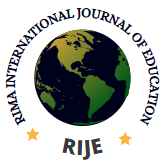Strategies for Improving Funds Acquisition and Management in Secondary Schools for Enhancing Teaching and Learning of Agricultural Education in Kano State, Nigeria
Idi Garba
Department of Science and Technology Education, Faculty of Education, Bayero University, Kano, Nigeria Email: idigarba926@yahoo.com
Abstract
The success or failure of any educational institution depends on the availability of funds and its effective management. This study was conducted to determine the strategies for improving funds acquisition and management in secondary schools for enhancing teaching and learning of agricultural education in Kano State. The study adopted survey research design. The population of the study was made up of 1190 consisting of 595 Bursars and 595 PTA Chairpersons of secondary schools in Kano State, Nigeria. A sample size of 292 consisting of 146 Bursars and 146 PTA Chairpersons were used. A structured questionnaire served as instrument for data collection. The instrument was subjected to validity by three experts. Reliability test was conducted through pilot study using the Cronbach’s Alpha method, which revealed 0.79 as the reliability coefficient. The data obtained were analysed using mean. standard deviation and t-test at 0.05 level of significance. The findings of the study among others were; donations of funds from Parent Teacher Association, and Non-Governmental Organizations. Principal should handle the matters of funds in a way that shows responsibility and accountability. Base on the findings, it was recommended that Management of public secondary schools in Kano State should use motivative strategies to generate funds through Non-Governmental Organizations.
Keywords
Secondary School, funds, fund acquisition, fund management
Reference
Daerefamama, G.O. (2022). Budgeting and accountability as fund management strategies and principals’ effective administration of public secondary schools in Rivers State. International Journal of Economics, Environmental Development and Society, 3(3), 288-307.
Federal Republic of Nigeria (2013). National Policy on Education. Lagos: Nigerian Educational Research and Development Council (NERDC).
Kalume, S.B & Peter, N. 2024). Financial management practices and funds management in public secondary schools in Kilifi County, Kenya. International Academic Journal of Economics and Finance. 4(2), 306-323.
Kano-Budget-Speech (2024). Presentation of the Kano State 2024 budget of restoration and transformation to the Kano State House of Assembly by His Excellency, Alhaji Abba Kabir Yusuf, the Governor of Kano State at the Kano State House of Assembly Chamber on Friday 27th october, 2023. Retrieved on November 28, 2024 from https://dataphyte.com.
Mike, A. & Nwachukwu, P.O. (2018). Principals fund management strategies for effective administration of public secondary schools in Rivers State. International Journal of Scientific Research in Education, 11(3B), 545-576.
Ndidiamaka, O.P. (2022). Principals’ fund management strategies: a panacea for effective administration of schools in Rivers State. Journal of Education and Society, 12(1), 2097-2110.
Nkechi, I & Nwanneka, U.L. (2019). Administrators’ fund acquisition strategies for quality assurance in public and private secondary schools in Anambra State, Nigeria. Journal of Educational Management and Poilcy,3 (1), 145 -163.
Nwafor, N. E., Uchendu, E. N. & Akani, C. O. (2015). Need for adequate funding in the administration of secondary education in Nigeria. Global Journal of Educational Research, 14 (1), 119 – 124.
Ogunyale, K. (2024). What is driving the trend of out-of-school children in Kano? Retrieved on November 28, 2024 from https://dataphyte.com.
Olajide, K., Odoma, M.O., Okechukwu, F.I. & Okhaimoh, K.I (2015). Problems of teaching agricultural practical in secondary schools in Delta State, Nigeria. International Journal of Innovative Education Research, 3 (2), 7- 12.
Raji, Y. R. (2023). Relationship between financial management and school effectiveness in public senior secondary schools in Sokoto Metropolis. International Journal of Advanced Academic and Educational Research, 13, (7), 98 – 112.
